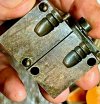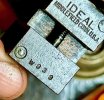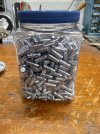I'm no expert for sure. But I've cast enough bullets to at least think I know what I am doing....
I get that and believe it. I'm not questioning your skill, experience or observations at all. I'm empathizing, which is of absolutely NO help, but acknowledging that if a skilled caster, such as yourself, with mould in-hand is a bit flummoxed, I'm sure I would be too.
Which circles back to my point that some new moulds make me question whether I have ANY clue as to what I'm doing with a casting pot to begin with. I've been casting since the early seventies, and USUALLY think I have a fair handle on it, but once in a while, a new mould will humble me very thoroughly.
One thing, which I have no scientific explanation for, is that when I DO get a mould like that, it usually hits a crescendo, wherein I cast like a manic with it for an hour, toss everything back in the pot, put the mould away and GIVE UP. Then, I get it back out one day and damned thing is a perfect angel! I suppose it's a bit like breaking a wild horse - hang on for the ride. It will eventually subside, but it WILL make you go through the whole gamut of aggravation and frustration.
NO, I'm not a cowboy. When I was six years old, a couple cowboy cousins hoisted my skinny little butt onto an unbroken horse (no saddle) they'd led home and it took off. The ONLY reason it didn't throw me was that I knew I'd die if it did, so I HUNG ON. By the time the horse settled down and they caught up, they were poopin' bricks, knowing they'd die at the hands of my mother if I died from their stunt. May sound funny, but every time I get a mould like that, I remember that day.

![20230427_201625[1].jpg 20230427_201625[1].jpg](https://www.artfulbullet.com/data/attachments/33/33640-a5f7d85267908b94f0f724459a675b77.jpg)


